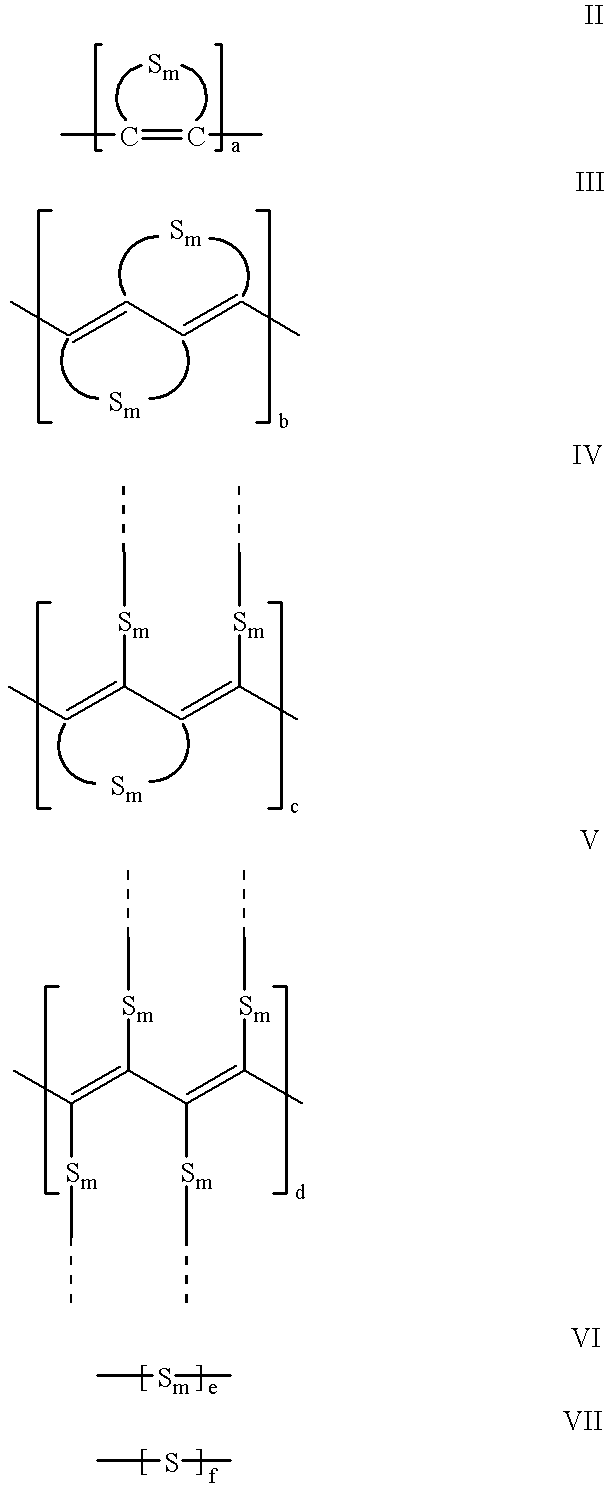Electroactive high storage capacity polyacetylene-co-polysulfur materials and electrolytic cells containing same
a polyacetylene-co-polysulfur, high-stable technology, applied in the direction of non-aqueous electrolyte cells, cell components, non-metal conductors, etc., can solve the problems of limited energy storage capacity, low storage capacity, and severely reduce the utility of organo-sulfur material as cathode-active material, etc., to achieve good electron transport, maintain charge neutrality, and fast electrochemical kinetics
- Summary
- Abstract
- Description
- Claims
- Application Information
AI Technical Summary
Benefits of technology
Problems solved by technology
Method used
Image
Examples
example 1
Into 250 mL of liquid ammonia with stirring was added 27.3 g (0.7 mol) of sodium amide. Through this solution was passed acetylene gas for 2.5 hours. To this reaction mixture was then added portion-wise 67.2 g (2.1 mol) of sulfur. The reaction mixture was stirred for an additional 7.5 hours, then 37.45 g (0.7 mol) of ammonium chloride was slowly added. The reaction mixture was allowed to warm to room temperature overnight, then 350 mL of water was added to the residue. The solid product was filtered, washed with water, then washed with acetone, and dried under vacuum The yield was 59.5 g; elemental analysis indicated 85 wt % sulfur.
example 2
A solution of sodium metal (2.3 g) in 200 mL of liquid ammonia containing 0.1 g of FeCl.sub.3 was stirred until the blue color disappeared. Then, acetylene gas was passed through the solution for 2 hr. at a rate of 50-70 mL / min. Elemental sulfur (9.6 g) was then added portionwise during 1 hr. The mixture was stirred for 2 hr. then the reaction solution was decanted from the excess sulfur. Excess ammonium chloride (5.35 g) was added to quench the reaction, and the reaction vessel was allowed to stand open to evaporate the liquid ammonia. To the residue was added 200 mL of water, and the product was filtered off, washed with water until a negative Cl.sup.- test was observed, then washed with acetone. The polymer was allowed to air dry to provide 1.0 g of a black polymer (S 65.6%). A further fraction of useful polymer was obtained by treating the aqueous extracts with 4.5 g of azobisisobutyronitrile at boiling temperature for 4 hrs. The resulting black polymer was filtered off, washed ...
example 3
A mixture of 1.4 g of small pieces of low density polyethylene and 6.4 g of sulfur powder was heated in a flask at 200.degree. C. for 3 h. During this time 1950 ml of hydrogen sulfide gas was collected from the reaction mixture. After cooling to room temperature 4 g of a black shinny polymer and 0.5 g of sulfur were removed from the reaction flask. Elemental analysis showed that the product contained 79.91 % of sulfur. Conductivity in the dark was 4.40.times.10.sup.-14 S / cm in vacuum and 1.06.times.10.sup.-13 S / cm in air.
PUM
| Property | Measurement | Unit |
|---|---|---|
| voltage | aaaaa | aaaaa |
| molar concentration | aaaaa | aaaaa |
| thickness | aaaaa | aaaaa |
Abstract
Description
Claims
Application Information
 Login to View More
Login to View More - R&D
- Intellectual Property
- Life Sciences
- Materials
- Tech Scout
- Unparalleled Data Quality
- Higher Quality Content
- 60% Fewer Hallucinations
Browse by: Latest US Patents, China's latest patents, Technical Efficacy Thesaurus, Application Domain, Technology Topic, Popular Technical Reports.
© 2025 PatSnap. All rights reserved.Legal|Privacy policy|Modern Slavery Act Transparency Statement|Sitemap|About US| Contact US: help@patsnap.com



